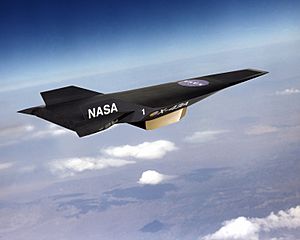Scramjet facts for kids

A scramjet is a special kind of jet engine. It's designed to fly incredibly fast, much faster than regular planes. Like other jet engines, it works by pushing hot air and gas out the back to create thrust. This thrust makes the aircraft move forward.
What makes a scramjet unique is how it gets its air. Unlike typical jet engines that use spinning parts (like a compressor) to squeeze air, a scramjet uses the aircraft's super-fast forward motion to ram and compress the air. This is why it's called a "ramjet" – it "rams" the air in.
Scientists and engineers have been working on scramjets since the 1950s. Their big goal is to make a scramjet that can fly at speeds up to Mach 15. That's 15 times the speed of sound! Imagine how fast that is – it's like going from New York to Los Angeles in minutes.
Contents
How Scramjets Work
Scramjet stands for "Supersonic Combustion Ramjet." This name tells us two important things about how it works.
Supersonic Airflow
In a regular jet engine, the air entering the engine slows down to subsonic speeds (slower than the speed of sound). But a scramjet is different. The air flowing through a scramjet always stays supersonic. This means the air inside the engine is moving faster than the speed of sound.
Burning Fuel at High Speed
For an engine to work, it needs to mix fuel with air and then burn it. In a scramjet, this burning (combustion) also happens at supersonic speeds. This is a huge challenge for engineers. It's like trying to light a match in a hurricane! Getting the fuel and air to mix and burn properly when everything is moving so fast is very difficult.
No Moving Parts
One of the coolest things about a scramjet is that it has almost no moving parts. Regular jet engines have big fans and compressors that spin very fast. These parts are heavy and can break down. A scramjet uses its shape and the speed of the aircraft to compress the air. This makes it simpler and potentially more reliable for very high speeds.
Why Scramjets are Special
Scramjets are designed for extreme speeds, much faster than any passenger plane today.
Flying at Hypersonic Speeds
When something travels at Mach 5 or faster, it's called "hypersonic." Scramjets are built to fly at these incredible hypersonic speeds. At such speeds, the air gets very hot and behaves differently. Scramjets are designed to handle these extreme conditions.
Potential for Space Travel
One day, scramjets might help us get into space more easily. Currently, rockets carry all their fuel and oxygen. Scramjets, like other jet engines, take oxygen from the air. This means they wouldn't need to carry as much oxygen, making spacecraft lighter and cheaper to launch.
Engineers hope to use scramjets for single-stage-to-orbit vehicles. This means a spacecraft could fly directly into orbit without needing multiple stages or booster rockets.
Challenges and Future
Building a working scramjet is very difficult. There are many challenges to overcome.
Extreme Heat
When an aircraft flies at hypersonic speeds, the air friction creates enormous heat. The parts of the scramjet engine and the aircraft itself must be able to withstand temperatures hotter than molten lava. New materials and cooling systems are needed to protect the engine.
Controlling the Burn
Making the fuel burn steadily and efficiently at supersonic speeds is another big challenge. The fuel and air only have a tiny fraction of a second to mix and ignite before they are pushed out the back of the engine.
Test Flights and Progress
Despite the challenges, engineers have made progress. For example, NASA's X-43A aircraft successfully flew using a scramjet engine. The Boeing X-51 Waverider also showed that scramjet technology can work. These test flights are important steps toward making scramjets a reality for future aircraft and spacecraft.
Images for kids
-
Test of Pratt & Whitney Rocketdyne SJY61 scramjet engine for the Boeing X-51
See also
 In Spanish: Scramjet para niños
In Spanish: Scramjet para niños




